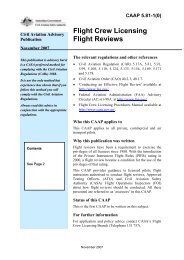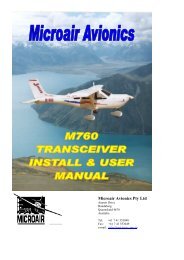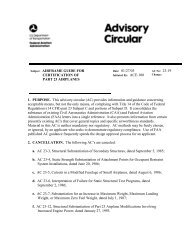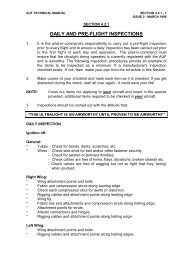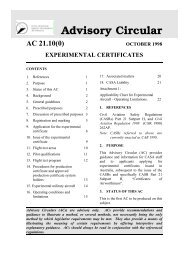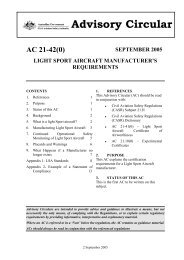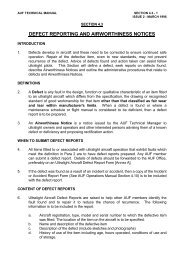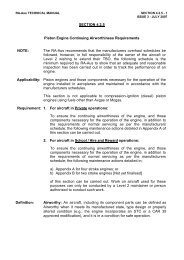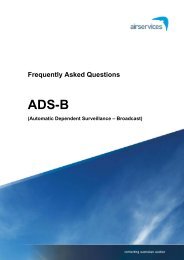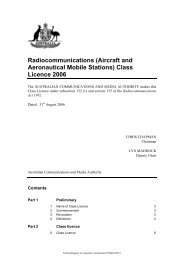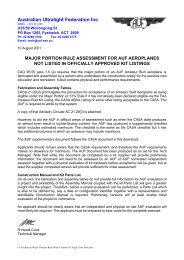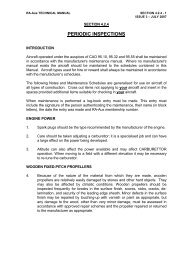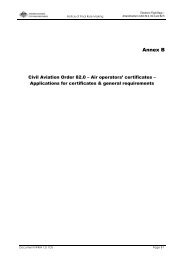Review of midair collisions involving general aviation ... - Fly Safe!
Review of midair collisions involving general aviation ... - Fly Safe!
Review of midair collisions involving general aviation ... - Fly Safe!
You also want an ePaper? Increase the reach of your titles
YUMPU automatically turns print PDFs into web optimized ePapers that Google loves.
• A pilot not using his radio to communicate was cited as a possible contributing<br />
factor in one <strong>of</strong> the aeroplane-aeroplane <strong>collisions</strong> at a non-towered aerodrome,<br />
with the pilot not making a base broadcast due to congestion on the radio<br />
frequency at the time. In the majority <strong>of</strong> the other <strong>collisions</strong>, there was evidence to<br />
suggest that pilots had made the appropriate radio broadcasts. In at least six <strong>of</strong> the<br />
aeroplane-aeroplane <strong>collisions</strong>, one or both <strong>of</strong> the pilots did not hear a radio<br />
broadcast made by the other pilot. Both pilots were not using radios in three <strong>of</strong> the<br />
aeroplane-glider <strong>collisions</strong>, and the glider pilot did not make appropriate<br />
broadcasts in another two <strong>of</strong> the <strong>collisions</strong>. In another aeroplane-glider collision,<br />
the aeroplane pilot did not broadcast on the glider frequency. 12<br />
• In at least six <strong>of</strong> the <strong>collisions</strong>, pilots were provided with and were aware <strong>of</strong> traffic<br />
information, but it was at least moderately likely that the pilot identified the wrong<br />
aircraft.<br />
• Actions by air traffic control personnel were directly involved in the <strong>midair</strong><br />
collision in the Coolangatta control zone in May 1988. Controllers not providing<br />
adequate traffic information probably also contributed to at least three <strong>of</strong> the<br />
<strong>collisions</strong> at the major <strong>general</strong> <strong>aviation</strong> airports.<br />
• High pilot workload or distractions were cited as a possible factor in at least three<br />
<strong>of</strong> the <strong>collisions</strong>. It is also likely that, in many <strong>of</strong> the other <strong>collisions</strong>, workload in<br />
the circuit area reduced the time available for searching for unknown traffic.<br />
• Cockpit visibility restrictions would have reduced the ability <strong>of</strong> at least one <strong>of</strong> the<br />
pilots to see the other aircraft during some <strong>of</strong> the later stages for many <strong>of</strong> the<br />
<strong>collisions</strong>. For example, on final approach there are usually significant cockpit<br />
visibility restrictions on one or both pilots seeing the other aircraft.<br />
Figure 2: Diagrammatic representation <strong>of</strong> collision angles involved in <strong>collisions</strong> not<br />
<strong>involving</strong> deliberately close flying activities<br />
The diagram does not include <strong>collisions</strong> with gliders, or <strong>collisions</strong> where aircraft were flying<br />
deliberately close.<br />
12 The then Bureau <strong>of</strong> Air <strong>Safe</strong>ty Investigation (BASI) has made recommendations regarding the use <strong>of</strong> radios by gliding<br />
operations. BASI was incorporated into the new Australian Transport <strong>Safe</strong>ty Bureau from July 1999.<br />
11



